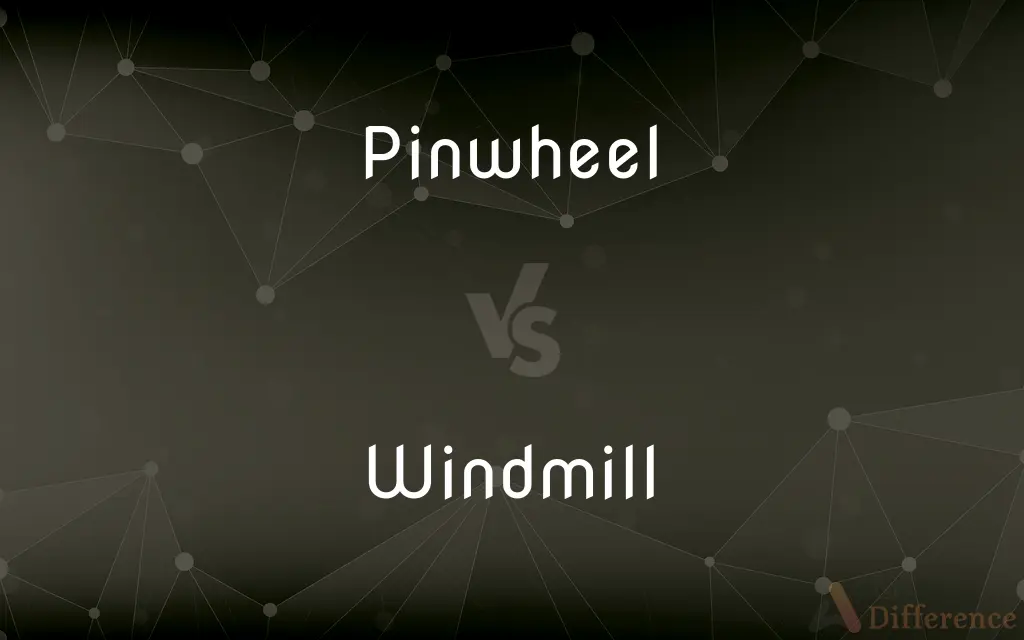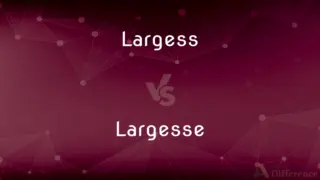Pinwheel vs. Windmill — What's the Difference?
By Urooj Arif & Fiza Rafique — Updated on April 3, 2024
A pinwheel is a small, handheld toy that spins when blown on, while a windmill is a large structure using wind power to perform work, such as grinding grain or pumping water.

Difference Between Pinwheel and Windmill
Table of Contents
ADVERTISEMENT
Key Differences
Pinwheels are playful, decorative objects often made of paper or plastic, mounted on a stick that allows them to spin freely in the wind. They are primarily used as toys or decorations, capturing the fascination of both children and adults with their colorful designs and simple, wind-driven motion. On the other hand, windmills are functional, engineering structures designed to harness the kinetic energy of wind for practical purposes. Historically, windmills have been used for grinding grain, pumping water, and more recently, generating electricity.
While pinwheels are characterized by their lightweight and vibrant appearance, designed for entertainment or aesthetic enhancement of outdoor spaces, windmills are constructed with durability and efficiency in mind, often featuring large wooden or metal blades attached to a complex mechanism. The purpose of windmills dictates their substantial size and sturdier construction materials, contrasting the delicate and decorative nature of pinwheels.
The operation of a pinwheel is straightforward and requires no mechanical complexity—simply blowing air or a gentle breeze is enough to make it spin. Windmills, however, utilize a more complex mechanism that converts wind energy into mechanical energy, often through a series of gears and shafts, to perform tasks such as milling or water pumping.
Pinwheels can be made at home with basic materials and serve as an educational tool to demonstrate wind power on a small scale. Windmills, in contrast, require significant engineering, planning, and resources to build and maintain, reflecting their role in agricultural, industrial, or renewable energy sectors.
Despite their differences in scale, complexity, and purpose, both pinwheels and windmills share the fundamental principle of being powered by wind. They each represent the human fascination with harnessing the power of the natural world, albeit at vastly different levels of application and sophistication.
ADVERTISEMENT
Comparison Chart
Primary Use
Toy or decoration
Grinding grain, pumping water, generating electricity
Material
Paper, plastic, light metals
Wood, metal, other durable materials
Size
Small, handheld
Large, requiring a foundation
Complexity
Simple, no moving parts besides the rotor
Complex, with gears, shafts, and sometimes generators
Purpose
Entertainment, aesthetic
Practical work, energy production
Mechanism
Spins freely in the wind
Converts wind energy into mechanical or electrical energy
Construction
Easily made with basic materials
Requires engineering and significant resources
Compare with Definitions
Pinwheel
A toy that spins in the wind.
The child delighted in the pinwheel spinning rapidly in the breeze.
Windmill
A structure for converting wind energy into mechanical power.
The old windmill still pumps water for the farm's irrigation system.
Pinwheel
A simple wind-driven device.
We placed colorful pinwheels in the garden as decorations for the party.
Windmill
A feature of landscapes, historically and currently.
The countryside was dotted with windmills, old and new.
Pinwheel
A decorative element for gardens or events.
The garden was alive with the movement of dozens of pinwheels.
Windmill
An engineering marvel of traditional and modern technology.
Windmills have evolved from grinding grain to generating clean electricity.
Pinwheel
An educational tool for demonstrating wind power.
The science teacher used a pinwheel to explain how wind energy works.
Windmill
A renewable energy source.
The new windmill is part of a project to increase our renewable energy output.
Pinwheel
A handheld wind spinner.
Each kid at the carnival received a bright pinwheel as a souvenir.
Windmill
A historical agricultural tool.
Windmills were essential for grinding grain before the industrial revolution.
Pinwheel
A toy consisting of vanes of colored paper or plastic pinned to a stick so that they revolve when blown on.
Windmill
A windmill is a structure that converts wind power into rotational energy by means of vanes called sails or blades, specifically to mill grain (gristmills), but the term is also extended to windpumps, wind turbines and other applications. The term wind engine is sometimes used to describe such devices.Windmills were used throughout the high medieval and early modern periods; the horizontal or panemone windmill first appeared in Greater Iran during the 9th century, the vertical windmill in northwestern Europe in the 12th century.
Pinwheel
A firework that forms a rotating wheel of colored flames. Also called catherine wheel.
Windmill
A machine that runs on the energy generated by a wheel of adjustable blades or slats rotated by the wind.
Pinwheel
A wheel with a circle of pins at right angles to its face, used as a tripping device.
Windmill
Something, such as a toy pinwheel, that is similar to a windmill in appearance or operation.
Pinwheel
An artificial flower with a stem, usually plastic, for children: the flower spins round in the wind, like a small paper windmill.
Windmill
To move or cause to move like the wheel of a windmill; rotate sweepingly.
Pinwheel
A firework which forms a kind of spinning wheel.
Windmill
A machine which translates linear motion of wind to rotational motion by means of adjustable vanes called sails.
Pinwheel
A cogged (toothed) gear.
Windmill
The structure containing such machinery.
Pinwheel
A pastry which resembles the artificial flowers above, with some filling or topping in the center.
Windmill
A child's toy consisting of vanes mounted on a stick that rotate when blown by a person or by the wind.
Pinwheel
Any food product consisting of layers (for example of pastry and sweet filling, or of bread and meat) rolled into a spiral, visually similar to a cinnamon roll.
Windmill
(basketball) A dunk where the dunker swings his arm in a circular motion before throwing the ball through the hoop.
Pinwheel
(ambitransitive) To spin.
The damaged fighter jet pinwheeled out of control, the g-forces pushing the pilot so hard he couldn't reach the ejection switch.
Windmill
(baseball) A pitch where the pitcher swings his arm in a circular motion before throwing the ball.
Pinwheel
Perennial subshrub of Tenerife having leaves in rosettes resembling pinwheels
Windmill
A guitar move where the strumming hand mimics a turning windmill.
Pinwheel
Circular-shaped firework; spins round and round
Windmill
A breakdancing move in which the dancer rolls his/her torso continuously in a circular path on the floor, across the upper chest, shoulders and back, while twirling the legs in a V shape in the air.
Windmill
Any of various muscle exercises in which a large deal of the body makes a great circle, typically one where a kettlebell is raised overhead and the torso is rotated to the other side with the hand reaching its foot (hitting the core, glutes, hamstrings, trapezius, rhomboids, deltoids and rotator cuffs) but sometimes even a windshield wiper.
Windmill
Any of various large papilionid butterflies of the genus Byasa, the wings of which resemble the vanes of a windmill.
Windmill
(juggling) The false shower.
Windmill
(metaphorical) An imaginary enemy, but presented as real.
Windmill
To rotate with a sweeping motion.
She ran down the hill, windmilling her arms with glee.
Windmill
(intransitive) Of a rotating part of a machine, to (become disengaged and) rotate freely.
The axle broke and the wheel windmilled in place briefly before careening through the wall.
Windmill
A mill operated by the power of the wind, usually by the action of the wind upon oblique vanes or sails which radiate from a horizontal shaft.
Windmill
A mill that is powered by the wind
Windmill
Generator that extracts usable energy from winds
Common Curiosities
Are windmills still used for grinding grain?
Yes, some historical or traditionally maintained windmills still grind grain, although it's less common with modern technology.
Can a pinwheel generate electricity like a windmill?
No, pinwheels are too simple and small to generate electricity; windmills are designed for that purpose.
What's the difference between a windmill and a wind turbine?
A windmill is traditionally used for mechanical work, like grinding or pumping, while a wind turbine specifically refers to converting wind energy into electricity.
How long have windmills been in use?
Windmills have been used for various purposes for over a thousand years, with early examples dating back to the 9th century.
How does a windmill work?
A windmill captures wind energy with its blades, converting it into mechanical energy through a rotating shaft and gears, used to perform work like grinding or pumping.
Are pinwheels only for children?
While often associated with children, pinwheels are enjoyed by people of all ages as decorations or educational tools.
How do windmills impact the environment?
Traditional windmills have minimal environmental impact, while modern wind turbines are considered a clean, renewable energy source, though their construction and operation have some ecological considerations.
How are pinwheels made?
Pinwheels can be made from simple materials like paper, a pin, and a stick, with the paper cut into a shape that allows it to catch the wind.
What are the benefits of using windmills for energy?
Windmills for energy production offer renewable, clean energy, reducing reliance on fossil fuels and lowering greenhouse gas emissions.
Can windmills operate without wind?
No, windmills require wind to function; without it, they cannot perform their intended tasks or generate energy.
Do modern windmills look like traditional windmills?
Modern wind turbines differ significantly in appearance from traditional windmills, with sleeker designs focused on maximizing energy generation.
Can the design of a pinwheel affect how well it spins?
Yes, the shape, size, and material of a pinwheel can influence its sensitivity to wind and spinning efficiency.
Are there different types of windmills?
Yes, there are several types of windmills, including post mills, tower mills, and smock mills, differing in construction and design.
Is it possible to visit windmills?
Many windmills, especially historic ones, are preserved as tourist attractions and can be visited.
How are windmills maintained?
Maintenance involves regular inspections, lubrication of moving parts, and repairs as needed to ensure efficient operation and longevity.
Share Your Discovery

Previous Comparison
Data vs. Payload
Next Comparison
Largess vs. LargesseAuthor Spotlight
Written by
Urooj ArifUrooj is a skilled content writer at Ask Difference, known for her exceptional ability to simplify complex topics into engaging and informative content. With a passion for research and a flair for clear, concise writing, she consistently delivers articles that resonate with our diverse audience.
Co-written by
Fiza RafiqueFiza Rafique is a skilled content writer at AskDifference.com, where she meticulously refines and enhances written pieces. Drawing from her vast editorial expertise, Fiza ensures clarity, accuracy, and precision in every article. Passionate about language, she continually seeks to elevate the quality of content for readers worldwide.













































